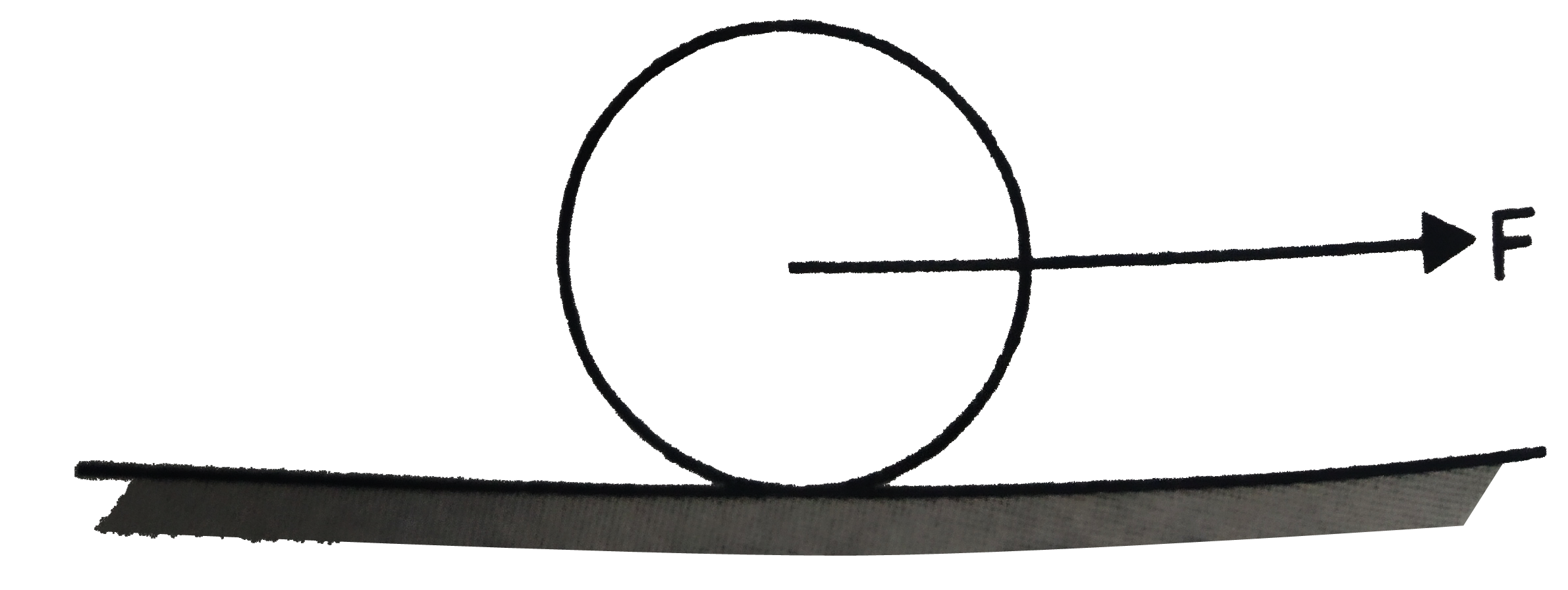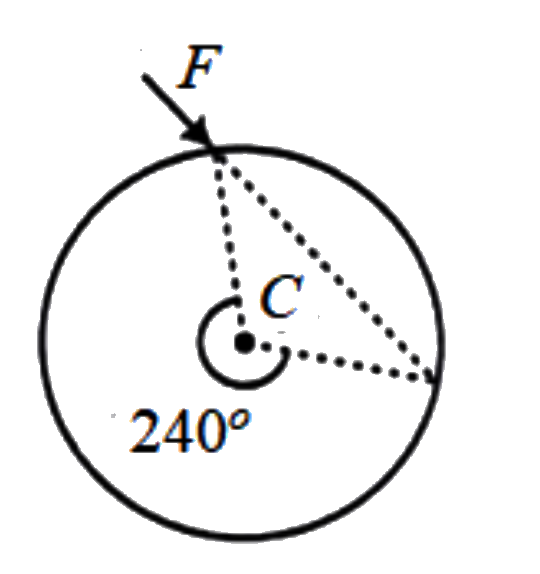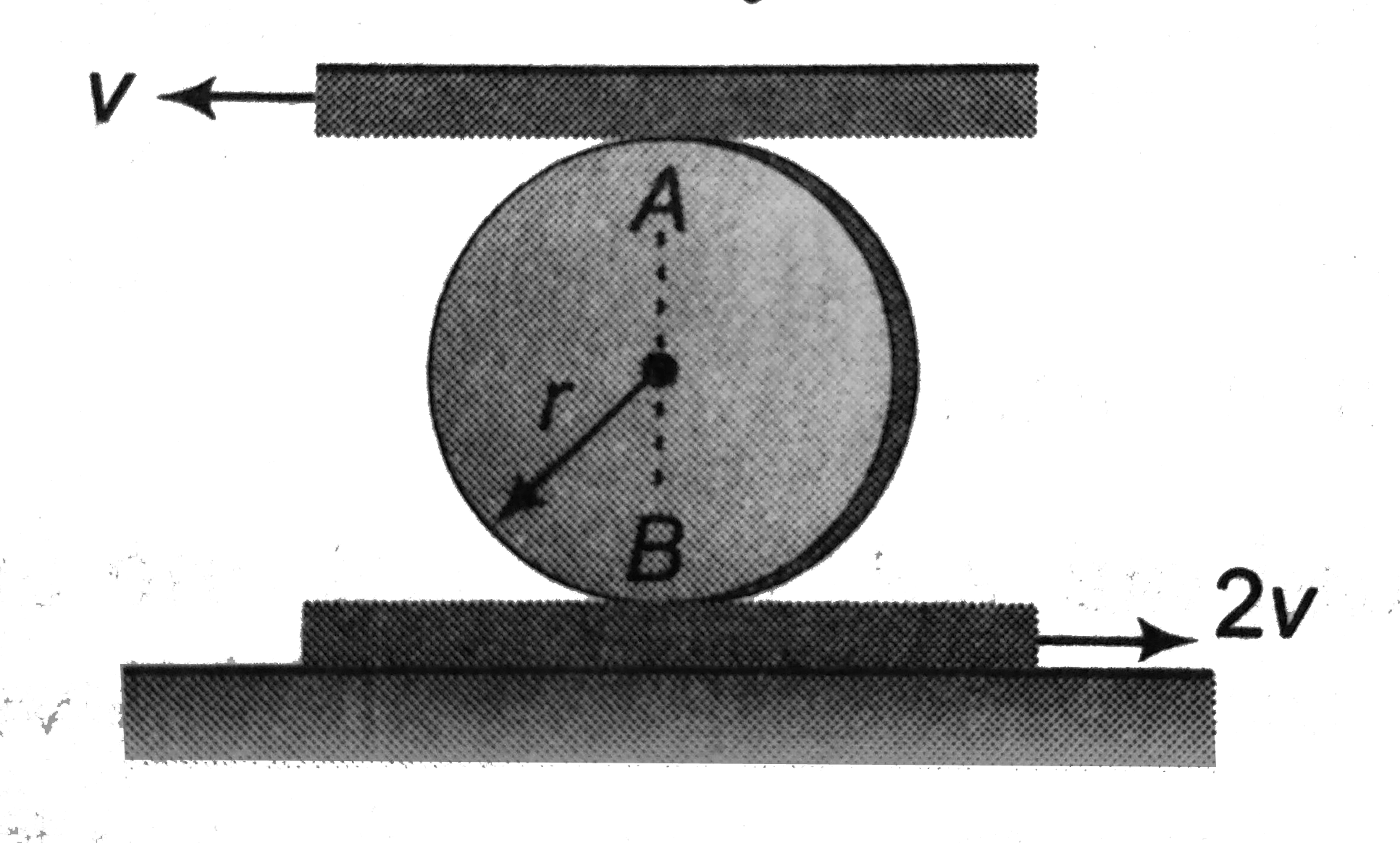A uniform disc of radius R is resting on a table on its rim.The coefficient of friction between disc and table is μ Fig 7.12. Now the disc is pulled with a force F as shown in the figure. What is the maximum value of F for which the disc rolls without slipping ?
Let the accelaration of the centre of mass of disc be ‘a’ thenMa = F-fThe angular accelaration of the disc is a = a/R. if there is no sliding. Then1/2MR2α = Rf⇒Ma = 2fThus f = F/3. Since there is no sliding ⇒ f ≤ μmg⇒ F ≤ μMg.
Related Solutions
A unifrom disc of radius , is resting on a table on its rim. The coefficient of friction between disc and table is Fig. Now the disc is pulled with a force as shown in the Fig. What is the maximum value of for which the disc rolls without slipping ?


View SolutionA unifrom disc of radius , is resting on a table on its rim. The coefficient of friction between disc and table is Fig. Now the disc is spulled with a force as shown in the Fig. What is the maximum value of for which the disc rolls without slipping ?


View SolutionA uniform disc of radius R, is resting on a table on its rim. The coefficent of friction between disc and table is mu (show in the figure). Now the disc is pulled with a force F . What is the maximum value of F for which the disc rolls without slipping?
View Solutionत्रिज्या R की कोई चक्रिका किसी मेज पर अपनी नेमि (किनारे) पर टिकी है। मेज तथा चक्रिका के बीच घर्षण गुणांक है। (चित्र ) अब आकृति में दर्शाए अनुसार बल F द्वारा चक्रिका को खींचा जाता है। वह अधिकतम बल ज्ञात कीजिए जिसमें अनुप्रयोग से चक्रिका बिना फिसले लोटन करती है।

View SolutionA disc of mass m and radius R is placed over a plank of same mass m. There is sufficient friction between disc and plank to prevent slipping. A force F is applied at the centre of the disc. Force of friction between the disc and the plank is
View SolutionA disc of mass m and radius R is placed over a plank of same mass m. There is sufficient friction between disc and plank to prevent slipping. A force F is applied at the centre of the disc. Force of friction between the disc and the plank is
View SolutionA uniform circular disc of mass m and radius R is rolling without slipping on a smooth horizontal surface as shown in figure. The disc collides with a rough vertical wall having coefficient of restitution . If the disc rolls without slipping after collision with the wall, and the coefficient of friction is n/10, then find n.

View SolutionA disc rotating about its axis with angular speed omega_0 is placed lightly (without any translational push) on a perfectly frictionless table. The radius of the disc is R . What are on the disc shown . Will the disc roll in the direction indicated?
View SolutionPassage VIII A disc of mass m and radius R is attached with a spring of force contant k at its center as shown in figure. At x-0, spring is unstretched. The disc is moved to x=A and then released. There is no slipping between disc and ground. Let f be the force of friction on the disc from the ground.

f versus t (time) graph will be as
View SolutionPassage VIII A disc of mass m and radius R is attached with a spring of force contant k at its center as shown in figure. At x-0, spring is unstretched. The disc is moved to x=A and then released. There is no slipping between disc and ground. Let f be the force of friction on the disc from the ground. f versus t (time) graph will be as
View SolutionPassage VIII A disc of mass m and radius R is attached with a spring of force contant k at its center as shown in figure. At x-0, spring is unstretched. The disc is moved to x=A and then released. There is no slipping between disc and ground. Let f be the force of friction on the disc from the ground. f versus t (time) graph will be as
View SolutionA uniform disc of mass M and radius R is hinged at its centre C. A force F is applied on the disc as shown. At this instant, the angular acceleration of the disc is
View SolutionA uniform disc of mass M and radius R is hinged at its centre C . A force F is applied on the disc as shown . At this instant , angular acceleration of the disc is
View SolutionA uniform disc of mass M and radius R is riveted at its center C. A force F is applied to the disc as shown. At this instant, the angular acceleration of the disc is:
View SolutionA uniform disc of mass M and radius R is hinged at its centre C . A force F is applied on the disc as shown . At this instant , angular acceleration of the disc is

View Solution
the disc of the radius r is confined to roll without slipping at A and B if the plates have the velocities shown, determine the angular velocity of the disc.
View Solution
the disc of the radius r is confined to roll without slipping at A and B if the plates have the velocities shown, determine the angular velocity of the disc.
View SolutionA disc roating about its axis with angular speed omega_(0) is placed lightly (without any translational pull) on a perfectly frictionless table. The radius of the disc is R . What are the linear velocities of the points A, B and C on the disc shown in Fig. Will the disc roll in the direction indicated ?
View SolutionA disc rotating about its axis with angular speed omega_(0) is placed lightly (without any translational pull) on a perfectly frictionless table. The radius of the disc is R . What are the linear velocities of the points A, B and C on the disc shown in Fig. Will the disc roll in the direction indicated ?
View SolutionA disc rotating about its axis with angular speed omega_(0) is placed lightly (without any translational pull) on a perfectly frictionless table. The radius of the disc is R . What are the linear velocities of the points A, B and C on the disc shown in Fig. Will the disc roll in the direction indicated ?
View Solution